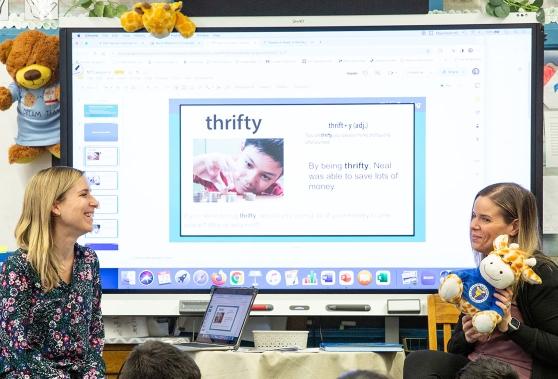
Jackie Rauer (left) and Maria Andreani share a laugh while co-teaching their 4th-grade ICT class at PS 32 in Flushing, Queens.
Many compare co-teaching to a marriage. “It is a very close relationship,” said Jaclyn Rapp, a general education teacher at PS 32 in Queens. “We spend just as much, if not more, time together than we do with our spouses and families.”
Wendy Murawski, a co-teaching expert and professor of education at California State University, uses a dance metaphor to describe the co-teaching relationship. “Doing the co-teaching dance requires establishing a rhythm and being familiar with the music,” she wrote.
But whatever the analogy, these relationships need two willing partners who are communicative, collaborative and cooperative to be successful.
Integrated co-teaching (ICT) classes were created in response to the goal of educating students with disabilities alongside general education students as much as possible.
These classes are taught by two teachers — a general education or content-area teacher and a special education teacher — who work together to modify instruction so all of their students can access the grade-level curriculum. Co-teaching becomes progressively more difficult and demanding at the middle and high school levels, where teachers have more students and more teaching partners and the course content is more challenging. In addition, the students with disabilities in these classes often lack foundational math and reading skills.
In recent years, ICT classes have proliferated in New York City public schools, while the Department of Education has limited or eliminated other options. But ICT classes should not be the only setting for students with disabilities at your school — a topic that your school’s Special Education Committee can raise at its meetings with the principal. Some students may need different or additional services to succeed.
The ICT class can, however, be a fitting learning environment when students are intentionally grouped based on the similarity of their needs and when co-teachers work well together, know how and when to group students, use co-teaching models flexibly and have adequate common planning time.
Elizabeth McGovern, a UFT special education liaison who was an ICT teacher for most of her career, said co-teachers in the same grade at her former elementary school grouped and regrouped their students for particular subjects and activities according to their skill levels.
“This intentional grouping allowed us to really target instruction so our students could progress,” McGovern said. “It also allowed students to work with all of the students in their grade and provided opportunities for them to shine.”
Students benefit from having two teachers who have different expertise and even different teaching styles. McGovern said she often approached subjects from a foundational stance while her co-teacher would demonstrate strategies. “There were two different ways students could learn from people, and they could either combine them or latch onto one that was most helpful,” she said.
Besides the advantages of being able to share grading and paperwork, co-teaching can provide more meaningful support and growth for each teacher, too.
Maria Andreani and Jackie Rauer, co-teachers at PS 32 in Queens, have been working together for 13 years as an ICT team. Andreani, the general education teacher of the pair, said she and Rauer are constantly learning from each other through seeing each other in action. “The way she’s wording something or the way she’s modeling something can inspire me to want to do it,” Andreani said.
Rauer said co-teaching allows them to confront and surmount challenges together. “You don’t feel like it’s all on you, there’s a shared responsibility,” said Rauer. “There’s always a colleague to go to for advice, and there’s nothing like getting advice from the person who’s also in the room with you who knows the kids.”
Classroom management is easier when there are two sets of eyes, but ICT classes also allow for greater flexibility to minimize disruptions. If a student is having a hard time, said McGovern, “the co-teacher can see what’s going on and intervene before the situation escalates.”
But back to the marriage and dance analogies: What if you wind up paired with a co-teacher who is commitment-phobic or has two left feet? Or what if you are a high school math or science teacher paired with a co-teacher who hasn’t been exposed to those subjects since high school?
Co-teachers say it’s important to talk it out if something isn’t working and not be afraid to ask for help. A successful partnership requires open communication and respect, said Tonia Donato, a special education teacher at PS 32 and Rapp’s co-teacher. Be willing to “relinquish some control,” she advised, and remember “there is never one right way to do something.”
It can be problematic if co-teachers feel responsible for just the general education students or just the students with disabilities.
“Don’t go into a partnership with that mindset,” advised Andreani. “It’s not about ‘These are my kids, and those are your kids.’”
“We’re always working together with all the kids and it’s a very inclusive environment,” Rauer added.
Co-teaching partnerships take time to develop, said Michelle Reddy, a general education teacher at PS 129 in Queens who has been co-teaching with special education teacher Debra Giana for 19 years. “Our first year of teaching together looked much different than our partnership now,” she said. “Have the mindset that the partnership is always a work in progress.”
Getting to know the other person is really the key to a successful partnership. “The more you know each other, the more comfortable you are around each other, which in turn results in your students being more comfortable in their learning environment,” said Giana.
Rauer and Andreani say their partnership works so well because they’ve built a friendship. “We trust each other and know that there’s no malice in anything that we do,” said Andreani. “Trust is key.”